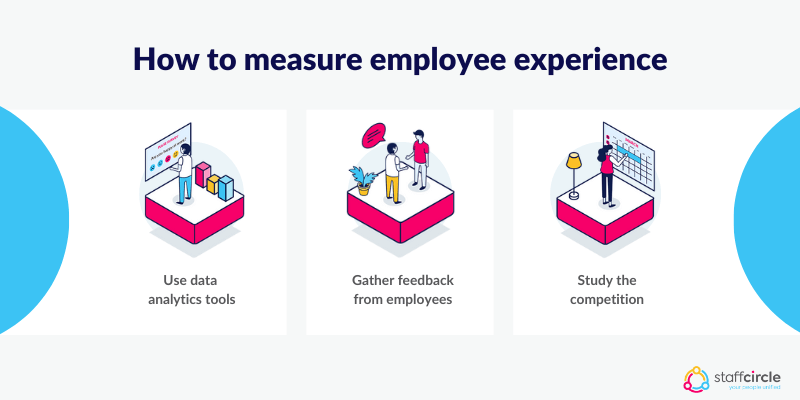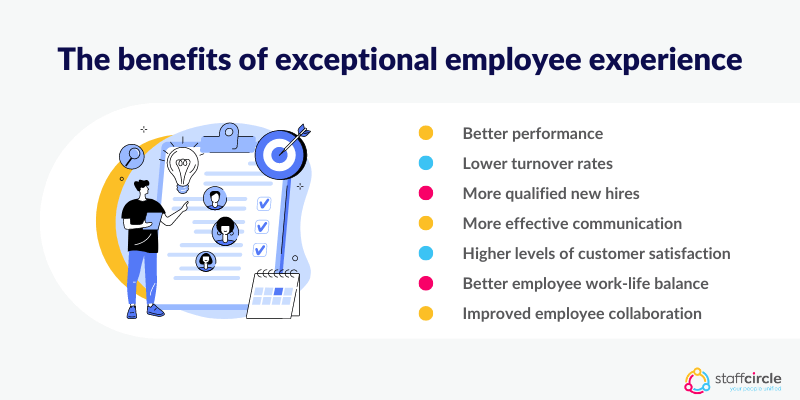Employee experience begins the moment a candidate accepts a role in a company, continuing up until they conduct their exit interview. This creates a broad range of touchpoints where business leaders can work to create a positive employee experience, enhancing productivity, engagement, and staff loyalty.
Read on to discover how you can craft a people strategy focused on employee experience. Learn how to build teams and departments of A-players who are committed to seeing your organisation succeed.
What is employee experience?
The employee experience, sometimes referred to as EX, relates to the broad range of interactions and touchpoints that help define how an employee feels about their time with the company. It can be measured throughout every stage of the employee lifecycle, from their onboarding experience and sense of career progression to the interactions they have with colleagues and managers.
In addition to these interactions, a positive employee experience is also shaped by their workspace and environment, both of which can have a significant impact on employee performance. The company’s culture and approach to technology can also help shape stronger employee satisfaction.
The most effective and successful companies understand the importance of working to craft the best employee experience possible. This is achieved through a wide range of processes and incentives, from intrinsic and extrinsic rewards to career development through lateral and vertical promotions.
Boost retention by improving employee experience
Discover the secrets to creating an irresistible workplace
What is the importance of employee experience?
A great employee experience not only helps to nurture and retain the best talent but it can also be used to attract new employees capable of delivering the best results. It fosters a workplace where staff is enthusiastic about their work and is committed to doing it to a high standard.
When the employee experience is rewarding, employees become more engaged and motivated, building stronger relationships with their peers and working better in teams. The end result is employees who are proud of what they do and excited to be a part of the company.
As Josh Bersin expressed it in his article, The Crusade for Employee Experience: How Did We Get Here?
“Employee Experience is a company-wide initiative to help employees stay productive, healthy, engaged, and on track. It’s no longer an HR project. It is now an enterprise-wide strategy, often led by the CHRO in partnership with the CIO. And it deals with all the day-to-day issues employees face at work.”
As such, business leaders should work to create an environment that maximises a positive work experience for their employees. This also means putting in place employee feedback systems to identify negative employee experiences as early as possible so that managers and HR professionals can step in early and address their personal or professional problems.
How to measure the impact of employee experience
Business leaders, HR professionals, and managers are in no position to improve the employee experience if they cannot measure their actions’ impact. In order to maximise the best courses of action, tools and processes are necessary to collate data for employee analytics and reports.
Use data analytics tools
The article from the Harvard Business Review, In A Hybrid World, Your Tech Defines Employee Experience, outlines the link between tech and experience:
“The technology experiences that employers provide will more or less define the employee experience — technology and workplace tools are, for all intents and purposes, the new workplace. As such, they’re becoming central in attracting and retaining new talent, fostering workplace culture, creating productivity, and more.”
This data can also be used to measure a positive employee experience in a variety of ways. Performance data taken from objectives and key results (OKR) tracking can help pinpoint individuals, teams, and departments who are lagging behind in their performance.
This data will highlight those individuals and teams who are having low employee satisfaction, so managers and HR leaders can focus on addressing their issues. Additional one2one sessions and other targeted feedback processes can then be implemented through performance management software.

Gather feedback from employees
This technology is central to effectively measuring the impact of employee experience across a variety of measurements and work domains. Employee Net Promotor Scores (eNPS) and other employee surveys can be used to gain broad insights into company-wide trends relating to engagement and job satisfaction.
Culture feedback surveys can also be used to help identify any disconnect between the workforce and the company’s core mission and values. This can be essential for maintaining a healthy alignment between the business and its employees.
When employees feel as if they are working towards shared goals, they invest more time and effort in their professional development. This feedback can also help drive better training and development decisions at the team and departmental level and assist with coaching and mentoring.
Study the competition
Finally, businesses can learn valuable lessons by observing the best practices of the leading companies, for instance, those featured on the Employee Experience Index. These approaches to creating a positive employee experience can help business leaders brainstorm new strategies to help improve their employer value proposition.
What is the difference between employee engagement and employee experience?
Increasing employee engagement is one of the main objectives of implementing a successful employee experience strategy. The definition of employee engagement incorporates employees’ commitment toward the company and their role and responsibilities. It also improves their relationships with others through regular and more meaningful interactions.
Strong and healthy engagement can have a huge positive impact on overall business outcomes. Various studies have demonstrated the link between engagement and positive financial results while at the same time helping to improve the mental and physical health and well-being of the workforce.
Recent data from Gallup suggests there is much to be done for companies to improve their employees’ experience through more robust engagement. Their report from 2022 indicates that just 21% of employees are engaged globally, with 19% of employees describing themselves as actively disengaged.
What are the benefits of an exceptional employee experience?
Delivering an exceptional employee experience confers a wide range of benefits, both for individuals and teams and the company at large. Some of the benefits include:
- A happier overall employee experience leads to better performance. When employees are happy and content, they are in a better frame of mind to focus on their work.
- Lower turnover rates, as employees prefer to remain with companies where they have invested time and effort in the outcomes. Offering challenging yet rewarding work is a great way to drive engagement and reduce turnover.
- Better qualified and more appropriate candidates will seek out employment with a company. Word is quick to spread when a company gains a bad reputation, but the same is true for great companies. A solid employee experience ensures the best and the brightest will apply for vacant positions, and is reflected in the hiring process.
- More effective communication between employees and their team leaders and managers. Since defining and refining what the best employee experience means to the workforce requires consistent communication, overall communication also benefits from EX initiatives.
- Higher levels of customer satisfaction. Productive and engaged employees have more vital interpersonal skills than those who are disenfranchised Improving the employee experience helps create better relationships with clients, working to improve services and products, and taking an active role in solving their issues.
- Employees develop a more robust work-life balance with higher levels of well-being. With the rise of hybrid working in the post-pandemic world, it’s easy for remote working employees to lack engagement. A comprehensive approach to the employee experience needs to include a focus on delivering the tools and resources for a great remote working experience.
- Employees become more capable of building relationships and collaborating effectively. Sharing knowledge and skills, serving as a coach or mentor, and otherwise giving employees greater access to the pool of expertise in the company is another core benefit of a solid employee experience.

How can you develop employee experience strategies?
As previously noted, the employee experience is felt at every stage of the employee lifecycle and in every domain of work and interactions. This creates many opportunities for business leaders and HR professionals to work towards improving the experience in as many ways as possible.
Some of these methods involve fine-tuning the foundations of how the company works by instigating a clear and consistent multi-channel communication system. This ensures all staff can keep up to date with their colleagues even when some may be working remotely. It also allows managers and team leaders to receive employee feedback and issue high-priority notifications with the ability to verify they have been read and understood.
Using performance management software allows for regular and consistent feedback on how well the employee experience is perceived. In addition to the employee surveys previously mentioned, this includes regularly scheduled one2one meetings and monthly and quarterly reviews.
Some other strategies which can help to drive a compelling employee experience strategy include:
Onboarding
Employee experience management begins when they start their first day at a new company. This first touchpoint should be the initial starting point for the development of a healthy and productive employee experience. A unique onboarding experience can lay the groundwork for a vibrant future and healthy relationships.
Consider the following when designing an onboarding process to enhance the employee experience framework:
- Conduct a thorough preboarding process. Before the new hire even begins their first day at work, crafting a great employee experience can begin. Work on compiling an impressive welcome pack tailored to their role and experiences, mentioning any perks and social benefits they can expect to enjoy.
- Plan out their first hours and days in the company with a clear schedule. When new hires begin in their role, they have a lot of meetings lined up to introduce them to their colleagues and direct reports. Make sure everyone involved is made aware of these meetings and given a primer on what the new hire will be doing at the company.
- Working closely with the new hire to create a clear and motivational personal development plan. Committed and enthusiastic new hires have a lot of energy that can be used to channel their career development with the company. Ensure their manager works closely with them to define a future vision that incorporates their ambitions with the company’s core strategic vision.
Attraction
Before onboarding a new staff member, you must ensure you’ve attracted the best candidate for a given role. This means building up an employer value proposition towards which the most talented employees are drawn. The employee experience – and the feedback gathered to help improve this – sit at the core of an employer value proposition that will attract the best talent.
Developing a strong company culture with clear and achievable values and goals can also help to attract A-players to an organisation. Such cultures need to be well articulated in the company’s literature and self-evident from a visit to the workplace. New hires coming in for interviews will instantly get a sense of the work environment, which can have a lasting impression that helps them decide whether to take on a role.
Retention
Common strategies used to increase employee retention are intimately linked to effective employee experience strategies. It stands to reason that those features and relationships at work that give employees a better experience will encourage them to stay in their role for longer compared to their dissatisfied colleagues.
Issues around salaries, work-life balance, boredom, lack of recognition, and other issues crucial for a healthy employee experience will improve retention when adequately addressed. Retention can be further enhanced through:
- Training and mentoring programs that show employees the company is committed to investing in their professional future.
- Wellness and healthy living opportunities, for instance, by assisting with ride-to-work schemes
- Creating more flexible working schedules
- Providing healthy food in the workplace.
- Broad recognition and rewards programs, whether in-person praise or digital rewards through performance management tools.
In Summary
The employee experience is a complicated phenomenon that affects every aspect of their role and responsibilities. While this may initially seem like a daunting task to approach in full, at the same time, it allows for multiple opportunities to step up and make improvements.
This guide has covered some of the best strategies available for businesses to create the best employee experience possible.





